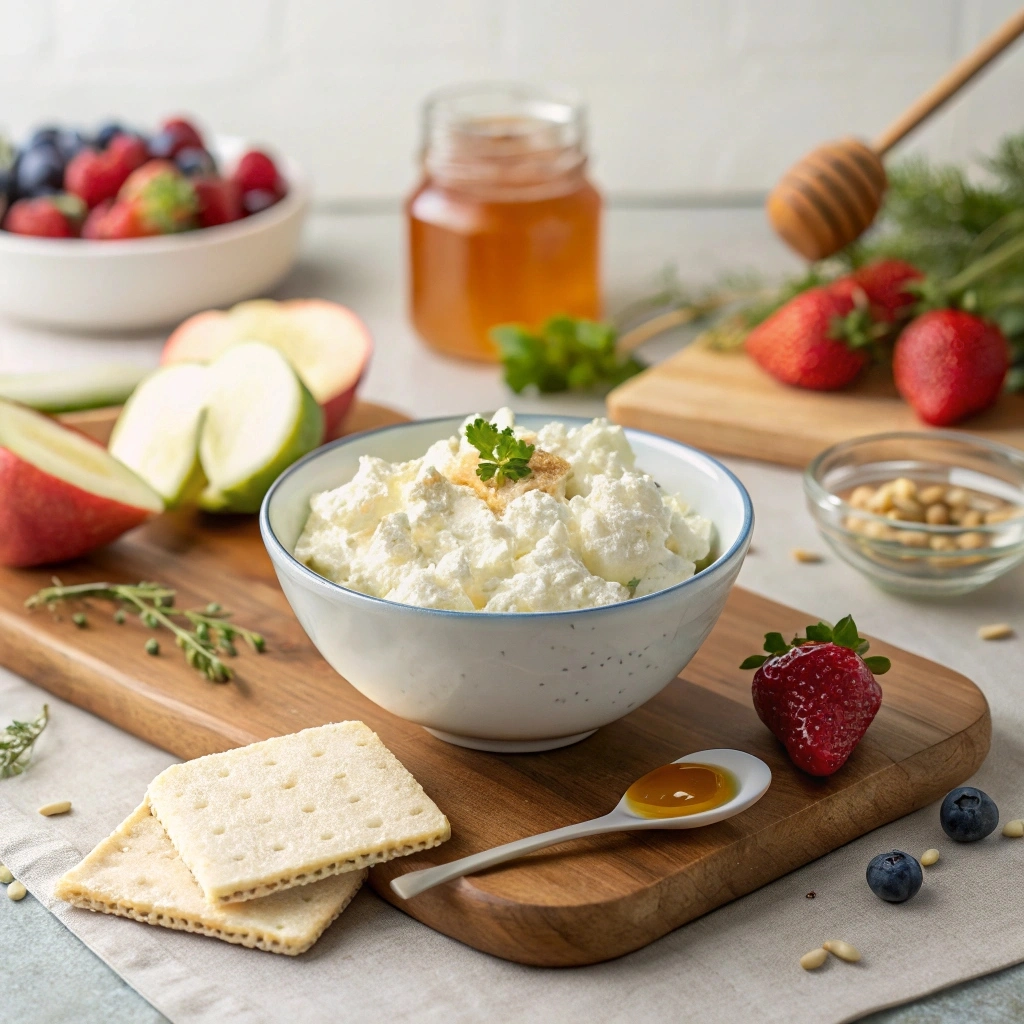Is cottage cheese the same as double cream? At first glance, these two dairy products might seem similar because both originate from milk. However, their textures, flavors, nutritional profiles, and culinary applications differ significantly. Cottage cheese, known for its high protein content and lumpy texture, is often used in healthy dishes. Meanwhile, double cream is celebrated for its luxurious richness and is a staple in indulgent desserts and sauces.
This article dives deep into the differences between cottage cheese and double cream, exploring their production processes, nutritional values, and culinary uses. By understanding these distinctions, you can confidently choose the right ingredient for your cooking and dietary needs.
Double cream is calorie-dense due to its high fat content. To learn more about the nutritional value of dairy products like double cream, visit Nutritional Value of Dairy Products.
Understanding Cottage Cheese
What Is Cottage Cheese?
Cottage cheese is a fresh, unaged cheese made by curdling milk. Unlike aged cheeses like cheddar or gouda, cottage cheese is mild, soft, and retains much of its natural moisture. Its unique texture and versatility make it a popular choice among health-conscious consumers.
How Is Cottage Cheese Made?
Cottage cheese production involves several steps:
- Curdling the Milk: Producers add an acidic agent like lemon juice, vinegar, or rennet to warm milk. This process causes the milk proteins, primarily casein, to coagulate into curds while the liquid whey separates.
- Draining the Whey: The curds are strained through cheesecloth or a fine sieve to remove the whey.
- Rinsing the Curds: The curds are washed to remove residual acidity, which gives the cheese a milder taste.
- Mixing in Cream: Some varieties include a small amount of cream mixed with the curds to improve texture and flavor.

Characteristics of Cottage Cheese
Texture and Flavor
- Texture: Cottage cheese has a lumpy, curdled consistency. The size of the curds varies, resulting in either small-curd or large-curd versions.
- Flavor: Its flavor is mild and slightly tangy, making it suitable for both savory and sweet recipes.
Nutritional Profile
Cottage cheese is often touted as a healthy food because of its impressive nutrient content:
- High in Protein: A single cup of cottage cheese contains about 28 grams of protein, making it a popular choice for athletes and those seeking to build muscle.
- Low in Fat and Calories: Non-fat or low-fat varieties contain fewer than 100 calories per serving, making them ideal for weight management.
- Rich in Micronutrients: It is an excellent source of calcium, phosphorus, selenium, and vitamin B12, all of which contribute to overall health.
Culinary Uses for Cottage Cheese
Cottage cheese is an incredibly versatile ingredient:
- Savory Dishes: Add it to salads, mix it into pasta, or use it as a filling for stuffed peppers.
- Baking: Substitute cottage cheese for ricotta in recipes like lasagna or cheesecake.
- Snacks: Pair it with fresh fruit, nuts, or granola for a quick, nutritious snack.
- Smoothies: Blend cottage cheese into smoothies to add protein and a creamy texture.
Understanding Double Cream
What Is Double Cream?
Double cream is one of the richest forms of cream available. With a butterfat content of approximately 48%, it has a luxurious texture and indulgent taste. Double cream is particularly popular in European cuisine, where it is used to elevate desserts and creamy sauces.
How Is Double Cream Made?
The production of double cream is simpler than that of cottage cheese:
- Separating Milk: Producers allow milk to sit so the cream naturally rises to the top. They then skim this cream layer off the milk.
- Pasteurizing the Cream: The cream is heated to destroy bacteria and extend its shelf life.
- Thickening (Optional): Some manufacturers add stabilizers or thickeners to create a denser texture.
Characteristics of Double Cream
Texture and Flavor
- Texture: Double cream is smooth, thick, and velvety, making it easy to whip into peaks for desserts.
- Flavor: Its rich, buttery taste complements both sweet and savory recipes.

Nutritional Profile
Double cream is calorie-dense due to its high fat content:
- Fat Content: With 48% butterfat, it is significantly richer than whipping cream or single cream.
- Calories: A tablespoon of double cream provides around 50 calories.
- Vitamins: It contains fat-soluble vitamins A and D, which are essential for bone health and immune function.
Culinary Uses for Double Cream
Double cream enhances recipes with its richness:
- Desserts: It is ideal for whipped cream, custards, trifles, and ice cream.
- Sauces and Soups: Use it to create creamy pasta sauces, gravies, or bisques.
- Toppings: Serve it alongside fresh fruit, pies, or puddings.
- Beverages: Add it to coffee, hot chocolate, or milkshakes for extra indulgence.
Comparing Cottage Cheese and Double Cream
Texture and Flavor
- Cottage Cheese: It has a lumpy texture with visible curds and a mild, tangy flavor. This makes it suitable for lighter, fresh-tasting dishes.
- Double Cream: It offers a smooth, thick texture and a rich, buttery flavor, making it the go-to choice for decadent recipes.
Nutritional Compariso
- Cottage Cheese: Low in calories and fat but high in protein and essential nutrients, making it ideal for healthy diets.
- Double Cream: High in calories and fat, with minimal protein content, making it better suited for indulgent, calorie-dense dishes.
Culinary Applications
- Cottage Cheese: Perfect for salads, dips, baked goods, and as a snack. It works well in recipes where a lighter texture or higher protein content is desired.
- Double Cream: Best for desserts, sauces, and creamy toppings. Its high fat content adds richness and smoothness to recipes.
Substituting Cottage Cheese for Double Cream
Can Cottage Cheese Replace Double Cream?
While you can sometimes substitute one for the other, their differences in texture and flavor mean adjustments are necessary:
- Blending Cottage Cheese: To mimic the texture of double cream, blend cottage cheese with a small amount of milk until smooth.
- Adding Flavor: Enhance the flavor by adding a pinch of salt or sugar, depending on the dish.
- Limitations: Cottage cheese cannot replicate the richness of double cream in desserts, but it works well in soups or savory sauces.
FAQs: Answering Common Questions About Cottage Cheese and Double Cream
1. Is Cottage Cheese the Same as Double Cream?
Not at all! Cottage cheese and double cream are two entirely different dairy products that vary greatly in texture, flavor, and nutritional composition. Cottage cheese is a fresh cheese made from curdled milk, known for its lumpy texture and mildly tangy flavor. It is especially popular for its high protein content and low fat, making it a staple in healthy and fitness-focused diets.
On the other hand, double cream is a thick, luxurious cream extracted from cow’s milk, with a smooth and velvety texture. It contains a high-fat percentage, often around 48%, which gives it a rich and indulgent taste. While cottage cheese is light and refreshing, double cream is dense and decadent, often used in desserts, pastries, or as a topping for rich dishes.
2. How Is Cottage Cheese Different from Double Cream in Recipes?
When it comes to culinary applications, the difference between cottage cheese and double cream is profound, making each more suitable for specific types of recipes. Cottage cheese, with its lower fat content and slightly acidic taste, works wonders in savory recipes like salads, stuffed vegetables, or healthy breakfast bowls. Its chunky texture adds an interesting element to dishes without overwhelming them with richness.
Conversely, double cream is a superstar in sweet and creamy recipes. Thanks to its silky texture and high-fat content, it excels in creating indulgent desserts like mousse, ice cream, or whipped toppings. It also serves as a luscious base for rich sauces and soups. Transitioning from one to the other in a recipe depends largely on the intended outcome, as they cater to opposite ends of the culinary spectrum.
3. Which Is Better for a Low-Fat Diet?
If you are watching your fat intake, cottage cheese is unquestionably the better choice. With significantly lower calories and fat compared to double cream, cottage cheese fits seamlessly into low-fat and weight-loss diets. It is often favored by athletes and health enthusiasts for its ability to provide ample protein while keeping the fat and calorie counts low.
In contrast, double cream, with its high-fat composition, is better suited for those indulging in richer meals or aiming to add extra calories to their diet. For individuals prioritizing health-conscious choices, the tangy lightness of cottage cheese is a far better fit than the decadence of double cream.
4. Is it possible to substitute double cream for cottage cheese?
Yes, but with significant caveats. Double cream can be used as a substitute for cottage cheese in some recipes, such as dips or spreads. However, it’s important to note that this substitution drastically alters the nutritional profile of the dish. Double cream’s high-fat content adds richness and creaminess but at the cost of increased calories and fat.
For example, replacing cottage cheese with double cream in a healthy dip recipe would shift it from being a low-calorie, protein-packed option to a heavier and more indulgent version. Therefore, while substitutions are possible, it is essential to consider the dish’s purpose and the intended nutritional balance.
Conclusion
Is cottage cheese the same as double cream? Absolutely not! While both are beloved dairy products, their distinct characteristics make them unique in their applications and appeal. Cottage cheese is a health-conscious option that stands out for its high protein content, tangy flavor, and chunky texture. It is ideal for those seeking a lighter alternative to add to salads, breakfast bowls, or savory snacks.
On the other hand, double cream offers an entirely different experience. Known for its smooth, velvety texture and rich, luxurious taste, it is the go-to ingredient for creating indulgent desserts, sauces, and creamy soups. Its high-fat content makes it perfect for those moments when decadence is the priority, but less suitable for health-focused dishes.
Transitioning between these two ingredients in recipes requires careful consideration. Each has its own strengths and purposes. Cottage cheese caters to light, low-fat meals, while double cream enhances the richness and flavor of heavier, indulgent dishes.
Informed choices matter when cooking or planning meals. If you are aiming for a healthier diet, cottage cheese is an excellent ally, providing protein without excess fat. On the other hand, double cream should be reserved for those special occasions when richness and flavor take center stage.
By understanding the differences between these two dairy products, you can better match them to your needs and preferences. Whether it’s a light snack or a decadent dessert, knowing when to use cottage cheese or double cream ensures the best results in your culinary creations.

